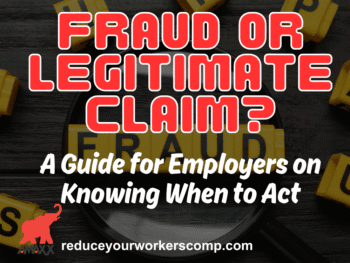
Average claim life continues to increase due to the injury severity and increasing medical treatment costs. While employers continue their involvement in processing claims to reduce costs, insurance companies/third-party administrators (TPA) also must do all they can to save on the costs of handling and controlling claims.
Immediate Steps to Reduce Increasing Costs
There are many steps interested stakeholders can take to reduce program costs. Here are some immediate steps to implement to run a better program immediately.
Click Link to Access Free PDF Download
“How Do I Get My Adjusters To Follow My Account Handling Instructions?”
-
Be aggressive with medical bill cost containment
There are several good service providers who do utilization review/cost containment at a reasonable cost. This includes a review of procedure codes depending on the TPA/insurance company’s participating medical network. Often what is missed is some providers are open to agreeing to a lower fee. If a popular physical therapy clinic in your area nets many, there is an opportunity to negotiate a fee-reduction price in exchange for “preferred provider” status.
-
Stay on top of your claims – Be proactive
Some claims remain open due to claim handler complacency. By proactively handling the file and using negotiation skills, claims may be resolved months earlier instead of lingering. Prioritize your files and stay on top of them and before you know it the claim is ready to be closed.
-
Use telephonic nurse case management
When an injured employee is off work, every day of lost wage is an expense. You want to do everything possible to bring the injured employee back to work as quickly as possible. Telephonic nurse case management (TNCM), as opposed to on-site nurse case management (NCM), gets the same result, for a quarter of the price. Cases needing a nurse usually demand more follow-up, easily done by phone. The nurse calls the employer, the injured employee, talks to the treating doctor’s nurse, obtains medical records, and performs other functions that take time and money. A TNCM frees the claim handler to work on other tasks the file needs, such as background checks, ISO searches, and vendor assignments. It also allows the claim handler to focus on case management and strategy, which advances a claim toward settlement.
The Utilization Review Accreditation Commission (URAC) is an umbrella organization responsible for certifying Nurse Case Managers (NCM); Triage Nurses (TN); Telephonic Case Management (TCM); Field Case Management (FCM); Utilization Management/Utilization Review (UM/UR); and Peer-to-Peer Review. To maintain quality control all these entities need URAC certification. URAC has stringent protocols for education, credentials, and training for these services.
-
Be on the lookout for claim “leakage”
Leakage is the biggest animal in the “reducing claim cost” jungle. Unnecessary costs, expenses, and errors in payments add up to astronomical amounts of money. These are often expenses workers’ compensation program are unable to recover. When reducing file leakage, it is important to audit your files and do so on a regular basis. File reviews are also an important opportunity to identify fraud, waste, and abuse, or stop it from occurring in the first place.
Conclusions
There are many steps one can take when reducing workers’ compensation costs, while at the same time maintaining the structural integrity of a program. It all starts with a willingness to review one’s program and look for opportunities to save money. It also requires all members of the claim management team and employers to be engaged and ready to implement change.

Author Michael Stack, CEO Amaxx LLC. He is an expert in workers’ compensation cost containment systems and helps employers reduce their workers’ comp costs by 20% to 50%. He works as a consultant to large and mid-market clients, is a co-author of Your Ultimate Guide To Mastering Workers Comp Costs, a comprehensive step-by-step manual of cost containment strategies based on hands-on field experience, and is founder & lead trainer of Amaxx Workers’ Comp Training Center .
Contact: mstack@reduceyourworkerscomp.com.
Workers’ Comp Roundup Blog: https://blog.reduceyourworkerscomp.com/
©2019 Amaxx LLC. All rights reserved under International Copyright Law.
Do not use this information without independent verification. All state laws vary. You should consult with your insurance broker, attorney, or qualified professional.
















